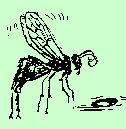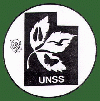|







|
. |
The Excavator Wasp
 On August 7, my family and I were at Cutler Dam on Bear River, west of
Logan, Utah. While walking from the power house to the dam, we noticed areas
on the dirt path where numerous holes or pits were dug into the soil.
Hovering over the holes were many slender wasps who seemed annoyed at our
trespassing. Their three pairs of legs were of unequal length, and hung
beneath them in a grotesque fashion as they flew about. I stopped to observe
their activity.
On August 7, my family and I were at Cutler Dam on Bear River, west of
Logan, Utah. While walking from the power house to the dam, we noticed areas
on the dirt path where numerous holes or pits were dug into the soil.
Hovering over the holes were many slender wasps who seemed annoyed at our
trespassing. Their three pairs of legs were of unequal length, and hung
beneath them in a grotesque fashion as they flew about. I stopped to observe
their activity.

 The holes, most of which were in the hard packed trail surface, had been dug
by the wasps for brood cells for their young. Wasps were still digging some
of them. They would scratch up dirt with their jaws and front legs, and then
kick the loose dirt out of the way. The holes were nearly vertical, and
seemed at least three inches deep. The inch and a half long wasp would
disappear down into the hole, and later back out dragging loose dirt. A
small, plastic vial was put over a hole down which a wasp had disappeared,
and it soon backed out into the vial. I was able to get the vial capped, and
then gave the specimen closer study.
The holes, most of which were in the hard packed trail surface, had been dug
by the wasps for brood cells for their young. Wasps were still digging some
of them. They would scratch up dirt with their jaws and front legs, and then
kick the loose dirt out of the way. The holes were nearly vertical, and
seemed at least three inches deep. The inch and a half long wasp would
disappear down into the hole, and later back out dragging loose dirt. A
small, plastic vial was put over a hole down which a wasp had disappeared,
and it soon backed out into the vial. I was able to get the vial capped, and
then gave the specimen closer study.


 The wasp was black, with exception of the forepart of the bulbous portion
and about half of the long, thread like part of the abdomen, which was
orange. Starting just above each of the last two pairs of legs, and sloping
diagonally forward, were silverish lines on the thorax. Above the front legs
were only silverish dots. The wasp had a fair sized head with long, curved
mandibles that overlapped considerably when closed. When open, the mandibles
looked like ice tongs, and could span a cylindrical object nearly a quarter
inch in diameter. The front legs were the shortest, the middle pair were next
in length, and the third pair were the longest, being as long as, or longer,
than the abdomen. In flight, the legs were held loosely, and hung down like
some strings or other fibrous material beneath the insect. The thorax was
large and powerful, containing large flight muscles as well as strong
muscles to control the upper part of the legs. The wings, shorter than the
abdomen, were about three fourths of an inch in length, and apparently were
adequate.
The wasp was black, with exception of the forepart of the bulbous portion
and about half of the long, thread like part of the abdomen, which was
orange. Starting just above each of the last two pairs of legs, and sloping
diagonally forward, were silverish lines on the thorax. Above the front legs
were only silverish dots. The wasp had a fair sized head with long, curved
mandibles that overlapped considerably when closed. When open, the mandibles
looked like ice tongs, and could span a cylindrical object nearly a quarter
inch in diameter. The front legs were the shortest, the middle pair were next
in length, and the third pair were the longest, being as long as, or longer,
than the abdomen. In flight, the legs were held loosely, and hung down like
some strings or other fibrous material beneath the insect. The thorax was
large and powerful, containing large flight muscles as well as strong
muscles to control the upper part of the legs. The wings, shorter than the
abdomen, were about three fourths of an inch in length, and apparently were
adequate.

 As I continued to watch these interesting insects, the function of their
oddly shaped jaws and legs became clear. I found one wasp carrying a
paralyzed caterpillar that was nearly 1/4 inch in diameter, and two inches
long. The sickle shaped jaws grasped the caterpillar just behind the head,
the short front legs held it a little behind this point, the middle legs
grasped it about midship farther back, and the long last legs clasped it
near the hind end. Thus the caterpillar was carried in line with the wasp's
body and was perfectly supported over its entire length by a four point
suspension so it could not sag. The caterpillar, several times larger than
the wasp, looked like a large torpedo being carried under a small plane.
As I continued to watch these interesting insects, the function of their
oddly shaped jaws and legs became clear. I found one wasp carrying a
paralyzed caterpillar that was nearly 1/4 inch in diameter, and two inches
long. The sickle shaped jaws grasped the caterpillar just behind the head,
the short front legs held it a little behind this point, the middle legs
grasped it about midship farther back, and the long last legs clasped it
near the hind end. Thus the caterpillar was carried in line with the wasp's
body and was perfectly supported over its entire length by a four point
suspension so it could not sag. The caterpillar, several times larger than
the wasp, looked like a large torpedo being carried under a small plane.

 The caterpillar was food for the larva or larvae of the wasp. Its paralyzed
condition kept it in a fresh state until the egg or eggs laid upon it hatched
and the young used up the meat. The caterpillar was taken into the hole head
first where, safely tucked away, eggs were laid upon it. The wasp then
covered over the hole with dirt and small pebbles. If all goes according to
nature, next spring, or summer, another wasp, or wasps, will emerge from
this cell to repeat this same ancestral pattern. This was one of the
thread waisted wasps of the genus Sphex whose caterpillar
hunts are well known.
-- by LeRoy Behling
The caterpillar was food for the larva or larvae of the wasp. Its paralyzed
condition kept it in a fresh state until the egg or eggs laid upon it hatched
and the young used up the meat. The caterpillar was taken into the hole head
first where, safely tucked away, eggs were laid upon it. The wasp then
covered over the hole with dirt and small pebbles. If all goes according to
nature, next spring, or summer, another wasp, or wasps, will emerge from
this cell to repeat this same ancestral pattern. This was one of the
thread waisted wasps of the genus Sphex whose caterpillar
hunts are well known.
-- by LeRoy Behling
|
|

